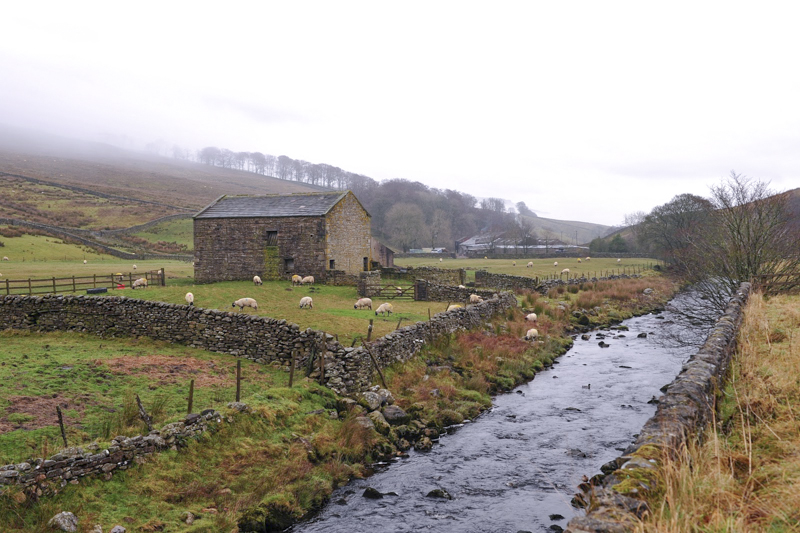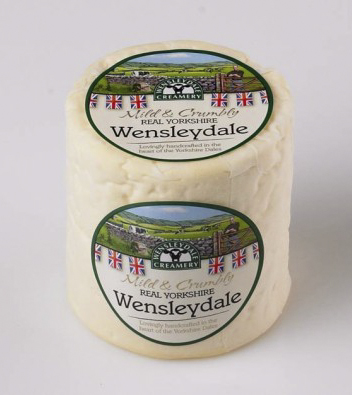Yorkshire Info
The Yorkshire Dales
Through the centuries there have been many names ascribed to this cheese, but the one that has lasted is Wensleydale® . Just the name will bring a smile to many faces. Folks will perhaps remember this as being the favorite cheese of Wallace and Grommit, or Mr. Wensleydale from the famous Monty Python skit, "The Cheese Shop".
What most people might not know, however, is that this is one of the most respected cheeses in the British Isles. It's roots go back many centuries to the early monastic colonization of England's North country.
Wensleydale® has always held a very important place in the history of cheese in England, even though production slid to low levels following the 2nd World War.
The Yorkshire Dales comprise a majestic area of northern England, tucked up against the border of Scotland and just to the east of the famous Lakes District. The area is known for its open expanses and fields, separated with ancient rock walls. It is perfect country for walking in, so many people are drawn to the region on weekends and holidays. This is also an area that I have spent much time photographing over the years.
At the end of a damp day, a warm pub, a pint of beer, and a bit of local cheese spells perfection!
What is Wensleydale® Style Cheese
The cheese is typically a creamy but crumbly cheese with a slightly acid taste. The unique flavor is said to be the result of the rocky limestone, producing qualities that no other region can seem to match. These soils give the cheese a gentle flavor, beautifully balanced by an underlying and slightly tart freshness.
The forms will vary considerably from tall forms to low flats, and vary in weight from 10-12 lbs down to smaller cheeses weighing only a pound or so. Today, some are sold in plastic wrap and others are still done in the traditional cloth bandage.
A Bit of History
This style of cheese was first made by French monks from the Roquefort region, who had settled in the Yorkshire Dales during the 12th century. They built a monastery and brought with them a recipe for making cheese from sheep's milk. Having come from the Roquefort area, it would be a reasonable expectation that this cheese might have been very similar to the base cheese for their Roquefort cheese, but there seems to be no record of this.
As the land was cleared into broad valley pastures into the 14th century, cows' milk began to be used instead, and the character of the cheese began to change. A little ewes' milk was still mixed in, since it gave a more open texture, and allowed the development of the blue mold. At that time, Wensleydale was almost always blue, while the white variety was almost unknown.
Wensleydale® was originally a seasonal cheese, made in farmhouses throughout the dales of North Yorkshire. In the early 1900s, there were hundreds of farms in these valleys. An interesting note is that the rennet used was made locally from the vells of the cows, and still referred to as prezzur, directly taken from the French présure used by the Monks that made the cheese originally.
As production increased over the years, the blue Wensleydale® was rarely seen. The monastery was dissolved in 1540 but the local farmers continued making the cheese right up until the Second World War.
Towards the end of the 1800s, a merchant named Edward Chapman, who had been buying cheese of varying quality, decided to take control by buying the milk from the cheese making farmers and making the cheese himself. Farmers found it easier to sell liquid milk than make it into cheese and some might argue that the advent of this large creamery reduced the number of cheese makers in the region. This large dairy in the small village of Hawes became known as the Hawes Creamery and was the primary producer of Wensleydale® cheese..
Beginning as early as 1933, prior to World War II, the government controls of cheese making demanded that most milk in the country was directed to the making of "Government Cheddar."
The Wensleydale® Creamery
Hawes Creamery carried on producing cheese through the two World Wars, providing stability for the farmers as a regular milk customer. However, Hawes was taken over by a larger dairy and, in 1992, they decided to close the creamery and move Wensleydale production to Lancashire. As much as this hurt the Yorkshire folks, it became an even more serious threat to the local dairy farmers. The creamery managers, workers and local people got together and arranged to take over Hawes Creamery. The independent Hawes Creamery was set up in 1993 and has prospered ever since. The larger dairy that closed them down shut their doors in 1994.
Today The Hawes creamery is known as "The Wensleydale® Creamery" and promotes themselves as "the only maker of Real Yorkshire Wensleydale® cheese". The only other producer of this style of cheese I could find was the Ribblesdale Cheese Co. which is a small scale family operation in the nearby Yorkshire Dales.
According to Randolph Hodgson of Neils Yard Dairy: "The Wensleydale® Creamery is a larger producer than we are used to working with, but despite their size, they still make their own starters and buy from local Dales farmers. In addition, the recipe they make for us (cloth-bound, traditional rennet, less starter and matured warmer) is a terrific tasting cheese."
Variations in Style
Traditionally, this cheese was made from ewes milk and most commonly as a blue cheese in a taller format. In its time the blue was said to have an even better quality reputation than the Stilton cheeses and was much in demand throughout England. However, the blues today are very hard to come by.
As the cheese was eventually converted to a cows milk cheese, the focus tended more towards the non-blue cheese and eventually evolved to a smaller flat format with diameter much greater than the height. Apparently it was due to larger scale operations and streamlining of the process but it became harder and harder to get the cheeses to go blue.
When the blue cheese was dominant, the difference in production was always for a more moist curd with less acid going into the final forms and the cheese was usually a tall form with natural Cloth Bandage.





































